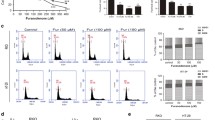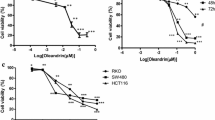Abstract
Purpose
Colorectal cancer is the most commonly diagnosed malignancy with high mortality rates worldwide. Improved therapeutic strategies with minimal adverse side effects are urgently needed. In this study, the anti-tumor effects of EF24, a novel analog of the natural compound curcumin, were evaluated in colorectal cancer cells.
Methods
The anti-tumor activity of EF24 on human colon cancer lines (HCT-116, SW-620, and HT-29) was determined by measures of cell cycle arrest, apoptosis, and mitochondrial function. The contribution of ROS in the EF24-induced anti-tumor activity was evaluated by measures of H2O2 and pretreatment with an ROS scavenger, NAC.
Results
The findings indicated that EF24 treatment dose-dependently inhibited cell viability and caused cell cycle arrest at G2/M phase in all the tested colon cancer cell lines. Furthermore, we demonstrated that EF24 treatment induced apoptosis effectively via enhancing intracellular accumulation of ROS in both HCT-116 and SW-620 cells, but with moderate effects in HT-29 cells. We found that EF24 treatment decreased the mitochondrial membrane potential in the colon cancer cells, leading to the release of mitochondrial cytochrome c. Also, EF24 induced activation of caspases 9 and 3, causing decreased Bcl-2 protein expression and Bcl-2/Bax ratio. Pretreatment with NAC, a ROS scavenger, abrogated the EF24-induced cell death, apoptosis, cell cycle arrest, and mitochondrial dysfunction, suggesting an upstream ROS generation which was responsible for the anticancer effects of EF24.
Conclusions
Our findings support an anticancer mechanism by which EF24 enhanced ROS accumulation in colon cancer cells, thereby resulting in mitochondrial membrane collapse and activated intrinsic apoptotic signaling. Thus, EF24 could be a potential candidate for therapeutic application of colon cancer.




Similar content being viewed by others
References
Torre LA, Bray F, Siegel RL, Ferlay J, Lortet-Tieulent J, Jemal A (2015) Global cancer statistics, 2012. CA Cancer J Clin 65(2):87–108. doi:10.3322/caac.21262
Ciombor KK, Wu C, Goldberg RM (2015) Recent therapeutic advances in the treatment of colorectal cancer. Annu Rev Med 66:83–95. doi:10.1146/annurev-med-051513-102539
Wilken R, Veena MS, Wang MB, Srivatsan ES (2011) Curcumin: a review of anti-cancer properties and therapeutic activity in head and neck squamous cell carcinoma. Mol Cancer 10:12. doi:10.1186/1476-4598-10-12
Geng C, Li J, Ding F, Wu G, Yang Q, Sun Y, Zhang Z, Dong T, Tian X (2016) Curcumin suppresses 4-hydroxytamoxifen resistance in breast cancer cells by targeting SLUG/Hexokinase 2 pathway. Biochem Biophys Res Commun. doi:10.1016/j.bbrc.2016.03.067
Ye M, Zhang J, Miao Q, Yao L (2015) Curcumin promotes apoptosis by activating the p53-miR-192-5p/215-XIAP pathway in non-small cell lung cancer. Cancer Lett 357(1):196–205. doi:10.1016/j.canlet.2014.11.028
Sharma RA, Euden SA, Platton SL, Cooke DN, Shafayat A, Hewitt HR, Marczylo TH, Morgan B, Hemingway D, Plummer SM, Pirmohamed M, Gescher AJ, Steward WP (2004) Phase I clinical trial of oral curcumin: biomarkers of systemic activity and compliance. Clin Cancer Res 10(20):6847–6854. doi:10.1158/1078-0432.CCR-04-0744
Zhang P, Bai H, Liu G, Wang H, Chen F, Zhang B, Zeng P, Wu C, Peng C, Huang C, Song Y, Song E (2015) MicroRNA-33b, upregulated by EF24, a curcumin analog, suppresses the epithelial-to-mesenchymal transition (EMT) and migratory potential of melanoma cells by targeting HMGA2. Toxicol Lett 234(3):151–161. doi:10.1016/j.toxlet.2015.02.018
Zhang D, Wang Y, Dong L, Huang Y, Yuan J, Ben W, Yang Y, Ning N, Lu M, Guan Y (2013) Therapeutic role of EF24 targeting glucose transporter 1-mediated metabolism and metastasis in ovarian cancer cells. Cancer Sci 104(12):1690–1696. doi:10.1111/cas.12293
Xiang T, Du L, Pham P, Zhu B, Jiang S (2015) Nelfinavir, an HIV protease inhibitor, induces apoptosis and cell cycle arrest in human cervical cancer cells via the ROS-dependent mitochondrial pathway. Cancer Lett 364(1):79–88. doi:10.1016/j.canlet.2015.04.027
Zou P, Xia Y, Ji J, Chen W, Zhang J, Chen X, Rajamanickam V, Chen G, Wang Z, Chen L, Wang Y, Yang S, Liang G (2016) Piperlongumine as a direct TrxR1 inhibitor with suppressive activity against gastric cancer. Cancer Lett 375(1):114–126. doi:10.1016/j.canlet.2016.02.058
Ling YH, Liebes L, Zou Y, Perez-Soler R (2003) Reactive oxygen species generation and mitochondrial dysfunction in the apoptotic response to Bortezomib, a novel proteasome inhibitor, in human H460 non-small cell lung cancer cells. J Biol Chem 278(36):33714–33723. doi:10.1074/jbc.M302559200
Newman DJ, Cragg GM (2016) Natural products as sources of new drugs from 1981 to 2014. J Nat Prod 79(3):629–661. doi:10.1021/acs.jnatprod.5b01055
Yuan X, Zhang B, Gan L, Wang ZH, Yu BC, Liu LL, Zheng QS, Wang ZP (2013) Involvement of the mitochondrion-dependent and the endoplasmic reticulum stress-signaling pathways in isoliquiritigenin-induced apoptosis of HeLa cell. Biomed Environ Sci 26(4):268–276. doi:10.3967/0895-3988.2013.04.005
Acharya A, Das I, Chandhok D, Saha T (2010) Redox regulation in cancer: a double-edged sword with therapeutic potential. Oxid Med Cell Longev 3(1):23–34. doi:10.4161/oxim.3.1.10095
Cairns RA, Harris IS, Mak TW (2011) Regulation of cancer cell metabolism. Nat Rev Cancer 11(2):85–95. doi:10.1038/nrc2981
Fiskus W, Saba N, Shen M, Ghias M, Liu J, Gupta SD, Chauhan L, Rao R, Gunewardena S, Schorno K, Austin CP, Maddocks K, Byrd J, Melnick A, Huang P, Wiestner A, Bhalla KN (2014) Auranofin induces lethal oxidative and endoplasmic reticulum stress and exerts potent preclinical activity against chronic lymphocytic leukemia. Cancer Res 74(9):2520–2532. doi:10.1158/0008-5472.CAN-13-2033
Gorrini C, Harris IS, Mak TW (2013) Modulation of oxidative stress as an anticancer strategy. Nat Rev Drug Discov 12(12):931–947. doi:10.1038/nrd4002
Raj L, Ide T, Gurkar AU, Foley M, Schenone M, Li X, Tolliday NJ, Golub TR, Carr SA, Shamji AF, Stern AM, Mandinova A, Schreiber SL, Lee SW (2011) Selective killing of cancer cells by a small molecule targeting the stress response to ROS. Nature 475(7355):231–234. doi:10.1038/nature10167
Zou P, Chen M, Ji J, Chen W, Chen X, Ying S, Zhang J, Zhang Z, Liu Z, Yang S, Liang G (2015) Auranofin induces apoptosis by ROS-mediated ER stress and mitochondrial dysfunction and displayed synergistic lethality with piperlongumine in gastric cancer. Oncotarget 6(34):36505–36521. doi:10.18632/oncotarget.5364
Yip NC, Fombon IS, Liu P, Brown S, Kannappan V, Armesilla AL, Xu B, Cassidy J, Darling JL, Wang W (2011) Disulfiram modulated ROS-MAPK and NFkappaB pathways and targeted breast cancer cells with cancer stem cell-like properties. Br J Cancer 104(10):1564–1574. doi:10.1038/bjc.2011.126
Jutooru I, Guthrie AS, Chadalapaka G, Pathi S, Kim K, Burghardt R, Jin UH, Safe S (2014) Mechanism of action of phenethylisothiocyanate and other reactive oxygen species-inducing anticancer agents. Mol Cell Biol 34(13):2382–2395. doi:10.1128/MCB.01602-13
Gandhy SU, Kim K, Larsen L, Rosengren RJ, Safe S (2012) Curcumin and synthetic analogs induce reactive oxygen species and decreases specificity protein (Sp) transcription factors by targeting microRNAs. BMC Cancer 12:564. doi:10.1186/1471-2407-12-564
Chintharlapalli S, Papineni S, Lei P, Pathi S, Safe S (2011) Betulinic acid inhibits colon cancer cell and tumor growth and induces proteasome-dependent and -independent downregulation of specificity proteins (Sp) transcription factors. BMC Cancer 11:371. doi:10.1186/1471-2407-11-371
Jutooru I, Chadalapaka G, Sreevalsan S, Lei P, Barhoumi R, Burghardt R, Safe S (2010) Arsenic trioxide downregulates specificity protein (Sp) transcription factors and inhibits bladder cancer cell and tumor growth. Exp Cell Res 316(13):2174–2188. doi:10.1016/j.yexcr.2010.04.027
Chadalapaka G, Jutooru I, Safe S (2012) Celastrol decreases specificity proteins (Sp) and fibroblast growth factor receptor-3 (FGFR3) in bladder cancer cells. Carcinogenesis 33(4):886–894. doi:10.1093/carcin/bgs102
Pathi SS, Jutooru I, Chadalapaka G, Sreevalsan S, Anand S, Thatcher GR, Safe S (2011) GT-094, a NO-NSAID, inhibits colon cancer cell growth by activation of a reactive oxygen species-microRNA-27a: ZBTB10-specificity protein pathway. Mol Cancer Res 9(2):195–202. doi:10.1158/1541-7786.MCR-10-0363
Jutooru I, Chadalapaka G, Abdelrahim M, Basha MR, Samudio I, Konopleva M, Andreeff M, Safe S (2010) Methyl 2-cyano-3,12-dioxooleana-1,9-dien-28-oate decreases specificity protein transcription factors and inhibits pancreatic tumor growth: role of microRNA-27a. Mol Pharmacol 78(2):226–236. doi:10.1124/mol.110.064451
Harris MH, Thompson CB (2000) The role of the Bcl-2 family in the regulation of outer mitochondrial membrane permeability. Cell Death Differ 7(12):1182–1191. doi:10.1038/sj.cdd.4400781
Cory S, Adams JM (2002) The Bcl2 family: regulators of the cellular life-or-death switch. Nat Rev Cancer 2(9):647–656. doi:10.1038/nrc883
Kluck RM, Bossy-Wetzel E, Green DR, Newmeyer DD (1997) The release of cytochrome c from mitochondria: a primary site for Bcl-2 regulation of apoptosis. Science 275(5303):1132–1136
Malumbres M, Barbacid M (2005) Mammalian cyclin-dependent kinases. Trends Biochem Sci 30(11):630–641. doi:10.1016/j.tibs.2005.09.005
Zhang Z, Wang H, Li M, Agrawal S, Chen X, Zhang R (2004) MDM2 is a negative regulator of p21WAF1/CIP1, independent of p53. J Biol Chem 279(16):16000–16006. doi:10.1074/jbc.M312264200
Ando T, Kawabe T, Ohara H, Ducommun B, Itoh M, Okamoto T (2001) Involvement of the interaction between p21 and proliferating cell nuclear antigen for the maintenance of G2/M arrest after DNA damage. J Biol Chem 276(46):42971–42977. doi:10.1074/jbc.M106460200
Hill DS, Martin S, Armstrong JL, Flockhart R, Tonison JJ, Simpson DG, Birch-Machin MA, Redfern CP, Lovat PE (2009) Combining the endoplasmic reticulum stress-inducing agents bortezomib and fenretinide as a novel therapeutic strategy for metastatic melanoma. Clin Cancer Res 15(4):1192–1198. doi:10.1158/1078-0432.CCR-08-2150
Wang CC, Chiang YM, Sung SC, Hsu YL, Chang JK, Kuo PL (2008) Plumbagin induces cell cycle arrest and apoptosis through reactive oxygen species/c-Jun N-terminal kinase pathways in human melanoma A375.S2 cells. Cancer Lett 259(1):82–98. doi:10.1016/j.canlet.2007.10.005
Verfaillie T, Garg AD, Agostinis P (2013) Targeting ER stress induced apoptosis and inflammation in cancer. Cancer Lett 332(2):249–264. doi:10.1016/j.canlet.2010.07.016
Zou P, Zhang J, Xia Y, Kanchana K, Guo G, Chen W, Huang Y, Wang Z, Yang S, Liang G (2015) ROS generation mediates the anti-cancer effects of WZ35 via activating JNK and ER stress apoptotic pathways in gastric cancer. Oncotarget 6(8):5860–5876. doi:10.18632/oncotarget.3333
Acknowledgements
The authors thank Professor Hazel Lum from Rush University (Chicago, Illinois) for language editing of the manuscript. The work was supported by National Natural Science Foundation of China (81572448 to H.Z., 81472307 to Y.W., 81560500 to Y.X., and 81160289 to Y.X.).
Author information
Authors and Affiliations
Corresponding authors
Ethics declarations
Conflict of interest
The authors disclose no potential conflict of interest.
Additional information
Guodong He and Chen Feng have contributed equally to this work.
Electronic supplementary material
Below is the link to the electronic supplementary material.
Rights and permissions
About this article
Cite this article
He, G., Feng, C., Vinothkumar, R. et al. Curcumin analog EF24 induces apoptosis via ROS-dependent mitochondrial dysfunction in human colorectal cancer cells. Cancer Chemother Pharmacol 78, 1151–1161 (2016). https://doi.org/10.1007/s00280-016-3172-x
Received:
Accepted:
Published:
Issue Date:
DOI: https://doi.org/10.1007/s00280-016-3172-x




